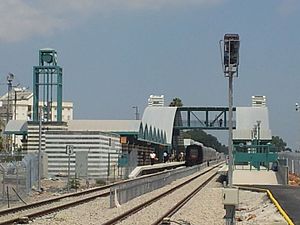Ramla Railway Station
|
Ramla Railway Station
תחנת הרכבת רמלה |
|
|---|---|
 |
|
| Location | Eli Cohen Street, Ramla |
| Coordinates | 31°55′45.68″N 34°52′36.62″E / 31.9293556°N 34.8768389°ECoordinates: 31°55′45.68″N 34°52′36.62″E / 31.9293556°N 34.8768389°E |
| Owned by | Israel Railways |
| Line(s) | Tel Aviv - Jerusalem |
| Platforms | 2 |
| Tracks | 2 |
| Construction | |
| Disabled access | Yes |
| History | |
| Opened | April 1891 |
| Closed | 1998 |
| Rebuilt | 2003, 2012 |
| Tel Aviv - Jerusalem inter-city line | |
|---|---|
Ramla Railway Station is a railway station in Ramla, Israel, on the Tel Aviv – Jerusalem line. The station is located in the east of Ramla. The station is also on a section shared with the Be'er Sheva - Tel Aviv line, which branches out in a southerly direction about 3 km east of Ramla.
Ramla Station was built as part of the Jaffa–Jerusalem railway, 22.5 km to the southeast of the Jaffa Railway Station; the first service to Jaffa began in April 1891. The original Jaffa Railway Station closed in 1948, when the line's western terminus was changed to Tel Aviv's Beit Hadar Station (also known as the Customs House Station), thus making Ramla the oldest active railway station in Israel.
During the unrest of the 1947–1948 Civil War in Mandatory Palestine the original station building was bombed by the Irgun on 27 May 1947.
In the 1950s a small concrete halt was built. On August 14, 1998, the station was closed since the section of line between Jerusalem and the Beit Shemesh Railway Station ceased operating due to deteriorating track conditions.
In 2001 it was decided to relocate the station to the west, closer to Ramla's city center and adjacent to the Ramla central bus station and civic center. The new Ramla station was opened on April 12, 2003, and service to Jerusalem resumed on April 9, 2005, the line having been completely renovated after being out of service for six years.
As part of the double-tracking and upgrading project of the Lod-Beersheba main line, the size of the station was doubled in 2012. Also as part of the project, the railway's route in the area was improved and actually no longer passes next to the original 1891–1998 station location.
...
Wikipedia
